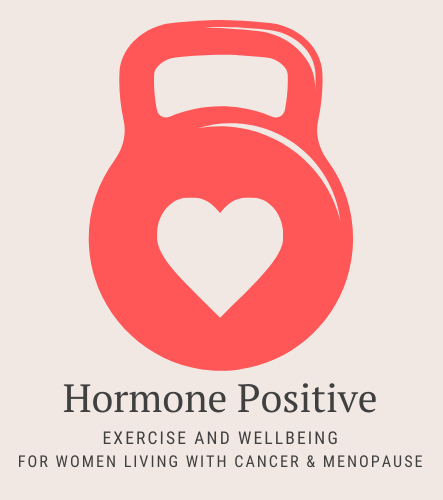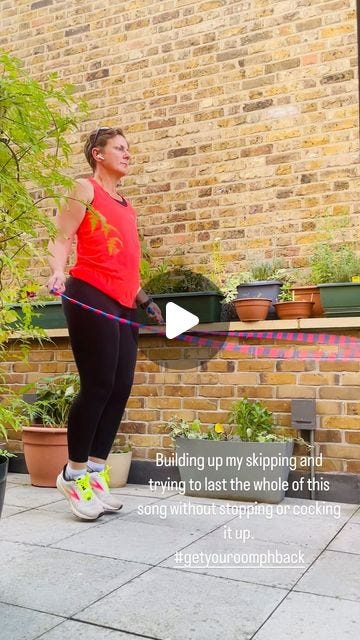Hormone positive
bounce | lift | fuel | chill - Introducing my plan for self-care for everyone affected by cancer and menopause.
It was a random day when the penny dropped. It wasn’t a particularly significant event, and not a time of reflection like new year can be, but shortly after my 55th birthday I decided to sketch out what I’d do to look after myself in the months until my next birthday.
I’d been playing around with different ideas, and I’d been devising a plan for self-care with the help of Dr Angela Sharma (more on her later). I was full of good intentions but what I lacked was focus and, to some degree, urgency. I’d been living in the aftermath of a breast cancer diagnosis for 3 ½ years and I had learnt a lot about how I could look after myself. I was trying to reduce my risk of the cancer coming back. I had learnt a lot about how I could cope with the myriad side effects of the drugs I had been prescribed that would keep that risk as low as possible. The drugs (tamoxifen, letrozole then, briefly, anastrozole) had caused all sorts of menopause-like symptoms, which at the time coincided with my body’s natural transition through menopause, so I was basically menopausal AF.
I felt I was getting to grips with all that, but I wanted to have a stronger sense of clarity. I guess I actually just needed to stop procrastinating.
‘Extreme self-care’
Maggie Chapman is a highly experienced therapist and author and is a specialist in Cognitive Behavioural Therapy. She’s a smart cookie. Maggie suggests that menopause is a time, second only in a woman’s life to pregnancy, that we could choose to practice what she describes as extreme self-care. I like this idea. It feels like encouragement, permission almost, to put ourselves first in a way we might not be familiar with. To ramp up the self-care.
I gave myself the rest of my 56th year to
· Get my body weight to healthy – I’ve always been fit, but heavy.
· Get my body fat to ‘athletic’. It had crept up slowly but surely while I was taking tamoxifen. For reasons that I’ll explain later, this, I promise you, is not body shaming/self-shaming on my part. Far from it: there are reasons why it’s in my best interest now for me to be a bit lighter and leaner than I’ve become.
· Get my oomph back. Yep, I know, I wrote the book on that. But I had just fallen into a normality that was less energetic, less fit, a bit ‘meh’ and, well, totally menopausal. I wanted to feel better.
My plan for me: bounce | lift | fuel | chill
As I read, and plotted, and thought about it, I came to think of my plan as having four distinct aspects: that I needed to bounce, to lift, to fuel myself and to chill out. My plan included some good habits that I’d try to adopt or strengthen. I hoped it would turn out to be ambitious but manageable:
· To chill more by doing a short yoga routine as often as I could. There’s a lovely flow that I learnt from Sage Rountree in her yoga for athletes teaching - 5 sun salutations in a flow with various warrior poses.
· That I’d get more bounce into my days, for my bones and heart, with my skipping rope. 100 skips/jumps on days I don’t run (or do outdoor personal training sessions).
· To learn to fuel myself differently by actively including more of some of the food groups that would help me to feel better.
· And to reap some of the benefits I’d learnt about through intermittent fasting, routinely keeping my daily eating to within a 10-11 hour window.
· As well as some more yoga, to have a daily chill, just five minutes if that’s all I had, with my acupressure mat.
· Bouncing by doing parkrun on Saturdays, because it is an event I love, and I love the community of active cancer folk that I’m part of though Move Against Cancer, 5k Your way.
· Lifting through weight training with the Big Strong Lasses three times a week. The lasses are awesome. More on them later.
· That I would train for, and complete, a 10k race, a half marathon, a trail race and then, if I felt fit enough, a marathon. These are all things that I love to do and that I’d not really felt I had the energy to do, or to commit to.
· To record whether I was feeling better with my own monthly health check and to have word with myself each month about how I was doing.
Who is this newsletter for?
So, this will be a monthly newsletter where I’ll trace out what I’m doing. I’m writing about the plan that was initially for myself, but that will become the foundation for the Hormone Positive training course that I’ll launch in a few weeks. The plan is the result of a whole heap of reading, listening, learning and plotting over the three and a half years since my cancer diagnosis and it’s how I’ve distilled all of the information I could get my hands on into a specific way of approaching self-care for this time of life. It’s how I’m putting building blocks in place for the rest of my life.
It’s intended for every woman who is going through, or has experienced, both cancer and menopause regardless of cancer type, grade or stage. It’s for anyone still in treatment, has finished treatment or will be on it for life.
I chose the name Hormone Positive as I wanted to find a way to react positively to the hormonal changes that had hit me, as they have so many of us, as part of the double whammy that is cancer and menopause.
So, it’s not just about hormone positive breast cancer – several types of cancer and cancer treatments can lead to a more difficult, complicated and often immediate menopause. Some cancer treatments can cause a return of menopause symptoms for women who thought they had already done their time there. There are the women whose breast cancer was hormone negative, and those with one of the BRCA genes that has resulted in preventative surgery and the consequent hormonal upheaval that goes along with it. Some of us can take HRT, lots of us can’t, or daren’t. Or we maybe can but the evidence is a bit unclear, or our GP isn’t sure and someone on Instagram said it’d be fine to and somebody else said definitely not.
We’re not all in exactly the same boat, but we are navigating the same sea. And sometimes that water gets a bit choppy.
The thing is though that time and time again the impact of exercise and nutrition is crystal clear. Evidence and guidelines bear witness to the value of us being as active, nourished and strong as we can be. We need to be savvy – things that worked for us pre-cancer and when we were younger just might not apply now and likewise there are things we can benefit from now that are of even greater importance than before (erm, hello, weight training!)
So, bounce, lift, fuel, chill.
Each month - a sharing plate
I have been soaking up information from some really smart women, who are professionals working in relevant fields, or have been through cancer and menopause themselves, or both. They are smarter than me, and know more than me, so I’m going to point you in their direction.
· First up is Dani Binnington, Founder of Menopause and Cancer – an organisation that has paved the way for better support and understanding. Her podcast is full of fantastic information and is incredibly useful. You’ll find Dani at www.menopauseandcancer.org
· Dr Angela Sharma is a GP, a menopause specialist with a specific interest in cancer, and is one half of Spiced Pear Health, who, amongst other things, run menopause workshops through Maggie’s Centres. Angela was absolutely instrumental in helping me work out how to look after myself. www.spicedpearhealth.co.uk
· Sage Rountree is a yoga teacher I have followed for years. She developed yoga for athletes – programmes that focus on the aches, pains and mentality of runners and triathletes. Some of her films are here: https://sagerountree.com/videos/
· Vicky Fox. If you’re new to yoga after your diagnosis, check out Vicky’s gorgeous Yoga for Cancer Classes. I took part in her Sunday classes when I was getting back on my feet and they were exactly what I needed. www.vickyfox-yoga.com
· Move Against Cancer – 5k Your Way is a wonderful way to get a bit more bounce into your life. Find them here: www.movecharity.org
· The Big Strong Lasses are the community of women affected by breast cancer that I do my weight training with, on zoom. They are a fabulous bunch. Here’s our basic weight training routine:
· Get Your Oomph Back is my book – a guide to exercise after a cancer diagnosis. If you’re new to exercising after your diagnosis, this will help you to get going. It’s available from all major booksellers, including amazon, and also directly from the publishers: www.hammersmithbooks.co.uk/product/get-your-oomph-back
Next edition
Next time I’ll write more about the four components of my plan, and how it’s going. Next month we will be bouncing :-)






Your page will be so helpful to so many women and great learning for me too.
V interesting and uplifting Carolyn. Will look at the links too including re yoga.
Look forward to the next installment.